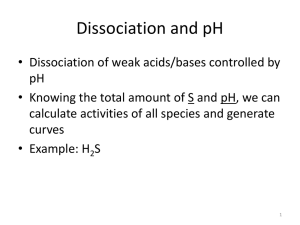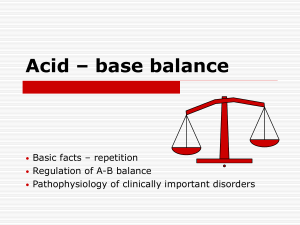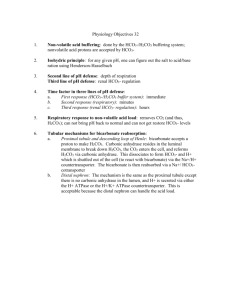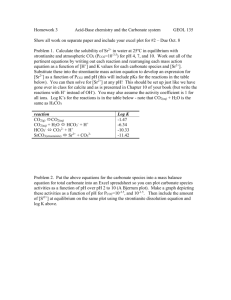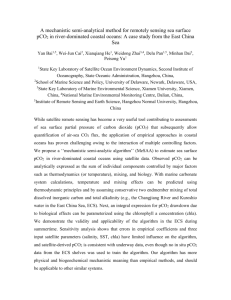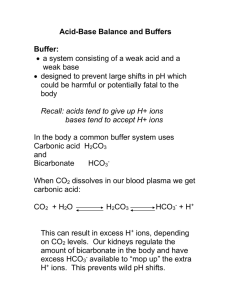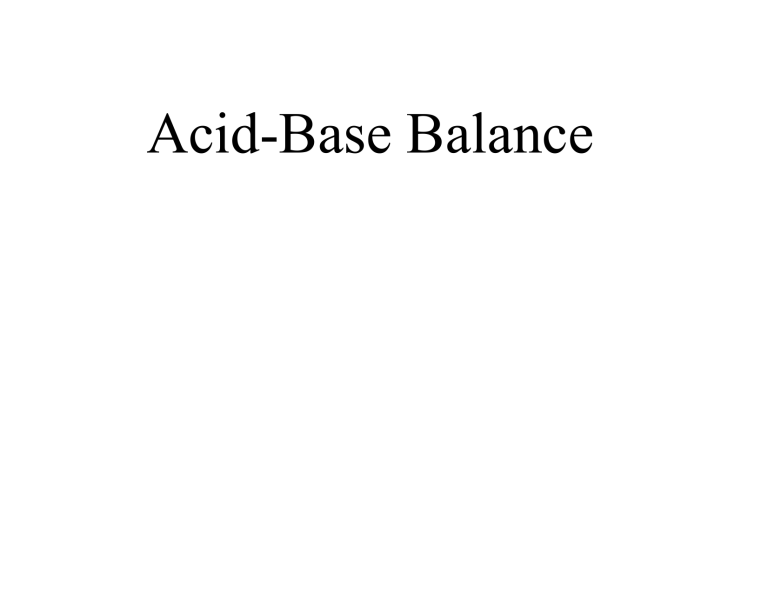
Acid-Base Balance H+ concentrations are regulated a very low levels: [H+] = 0.00004 mEq/L pH =−log[H+] mEq one thousandth (10-3) of a gram equivalent of a chemical element, an ion, a radical, or a compound. [Na+] = 142 mEq/L ACID-BASE REGULATION Metabolic reactions are very sensitive to changes of ambient pH and the body fluids are maintained within a very narrow range of values. The extracellular pH is generally in the range 7.35 - 7.45 Several mechanisms are available to keep pH within these limits 1. Extracellular buffering 2. Adjustments to blood PCO2 by altering the ventilatory capacity of the lungs 3. Adjustments to renal acid excretion or base reabsorption Very Basics (and Acidics) Acid: proton donor Base: proton acceptor Weak acid or base: acid or base that incompletely dissociates Buffer: Reduces changes in pH resulting from the addition of strong acides or bases Quantifying acidity: pH =−log[H+ ] Sources of acid Metabolism (volatile acid) CO2 is greatest source of H+ via oxidation of glucose and fatty acids Fixed or non-volatile acids produced during metabolism H2SO4 from sulfur-containing amino acids Phosphoric acid Hydrochloric acid Lactic acid (anaerobic metabolism product) some of this is converted to CO2 Buffering Bicarbonate Phosphate Proteins Henderson-Hasselbalch Equation HA↔H+ + A− pH = pKA + log [A− ] [HA] The pKA is the negative log of the dissociation constant. The carbonic anhydrase reaction is: CO2 + H2O CA H2CO3 H+ + HCO3- The first step is relatively slow and requires catalysis by the enzyme carbonic anhydrase (CA). The buffer system is under the dual regulation of the lungs and the kidneys Normal [H+] = 0.00004 mEq/L or 40 nEq/L Normal variation in [H+] is 3-5 nEq/L Extreme variation is 10 nEq/L [H+] is expressed in log scale using pH units pH =−log[H+] Bicarbonate System Buffer value = ∆[HCO3− ]/∆pH In the presence of carbonic anhydrase Then, CO2 + H2O ←CA → H2CO3↔ H+ + HCO3− pH = pKHCO3 + log [HCO3− ] [CO2 ] pH = 6.1+ log [HCO3− ] [0.03· PCO2 ] PaCO2=40 mmHg [HCO3-]=24 mEq/L pH = 6.1+ log [HCO3− ] [0.03· PCO2 ] pH = 6.1+ log 24 0.03* 40 pH = 6.1 + log 20 pH = 6.1 + 1.3 pH = 7.4 = What happens when acid is added? CO2 + H2O CA H2CO3 H+ + HCO3- Lungs The [CO2], or PCO2 will increase and removed by increased ventilation. What would happen if the CO2 were increased? CO2 + H2O CA H2CO3 H+ + HCO3- The HCO3- will rise removed by the kidneys. pH = 6.1+ log [HCO3− ] [0.03· PCO2 ] Kidneys Lungs Kidneys pH =Constant+ Kidneys Lung Phosphates H2PO4 ↔ H+ + HPO4= pK = 6.8 Other organic phosphates can act as buffers glucose-1-phosphate ATP Proteins pKs range from 5.5 to 8.5 Hb has histidine residues (pKs 7 to 8) Deoxyhemoglobin is a weaker acid than oxyhemoglobin As O2 leaves Hb, more H+ attaches to Hb, allowing increased CO2 to be transferred as bicarbonate Reversed in the lungs THE RELATIONSHIP BETWEEN PLASMA pH, [HCO3-] and PCO2 The Davenport diagram expresses the relationship between these variables [HCO3-], mM 32 60 mm Hg 40 mm Hg 20 mm Hg 28 24 Blood Buffer Line 20 16 12 7.1 7.2 7.3 7.4 7.5 7.6 7.7 pH pH = 6.1+ log [HCO3− ] [0.03· PCO2 ] [HCO3-] mEq 32 40 mm Hg MOH- 28 RH+ 24 N ROH- Blood 20 Buffer Line MH+ 16 12 7.1 7.2 7.3 7.4 7.5 7.6 7.7 pH RESPIRATORY ACIDEMIA A retention of CO2 generally caused by respiratory problems, hypoventilation [HCO3-], mM 60 mm Hg 32 28 40 mm Hg 20 mm Hg 1 24 20 16 12 7.1 pH = 6.1+ log [HCO3− ] [0.03· PCO2 ] 7.3 7.5 7.7 pH PCO2 is raised, pH is reduced HCO3- is normal COMPENSATED RESPIRATORY ACIDEMIA Compensation attempts to restore the pH towards normal [HCO3-], mM 32 40 mm Hg 2 28 20 mm Hg 1 24 Although the PCO2 remains elevated the pH approaches a normal value 60 mm Hg 20 16 12 7.1 7.3 7.5 pH The kidney retains base, i.e. HCO3- 7.7 PCO2 is raised, pH is normalised HCO3- is raised pH = 6.1+ log [HCO3− ] [0.03· PCO2 ] RESPIRATORY ALKALEMIA Excessive loss of CO2 generally caused by hyperventilation [HCO3-], mM 60 mm Hg 32 40 mm Hg 20 mm Hg 28 1 24 20 16 12 7.1 pH = 6.1+ log [HCO3− ] [0.03· PCO2 ] 7.3 7.5 7.7 pH PCO2 is reduced, pH is raised HCO3- is normal COMPENSATED RESPIRATORY ALKALEMIA [HCO3-], mM 60 32 mm Hg 40 mm Hg 20 mm Hg 28 Although the PCO2 remains reduced the pH approaches a normal value 1 24 20 2 16 12 7.1 7.3 7.5 pH The kidney loses net base, i.e. HCO3- 7.7 PCO2 is reduced, pH is normalised HCO3- is lowered pH = 6.1+ log [HCO3− ] [0.03· PCO2 ] METABOLIC ACIDEMIA Many different diseases and medical conditions lead to metabolic acidosis [HCO3-], mM 60 mm Hg 32 Diabetes Heart failure Renal failure Diarrhoea 24 40 mm Hg 20 mm Hg 28 1 20 16 12 7.1 pH = 6.1+ log [HCO3− ] [0.03· PCO2 ] 7.3 7.5 7.7 pH PCO2 is unchanged, pH is reduced HCO3- is reduced COMPENSATED METABOLIC ACIDEMIA [HCO3-], mM 60 mm Hg 32 40 mm Hg 20 mm Hg 28 24 1 20 16 Although the HCO3remains reduced the pH approaches a normal value 2 12 7.1 7.3 The lungs excrete more CO2 hyperventilation 7.5 7.7 pH pH = 6.1+ log [HCO3− ] [0.03· PCO2 ] HCO3- is reduced, pH is normalised PCO2 is lowered METABOLIC ALKALEMIA Example: net loss of H+; e.g. through vomiting [HCO3-], mM 60 mm Hg 32 28 40 mm Hg 20 mm Hg 1 24 20 16 12 7.1 pH = 6.1+ log [HCO3− ] [0.03· PCO2 ] 7.3 7.5 7.7 pH PCO2 is unchanged, pH is increased HCO3- is increased COMPENSATED METABOLIC ALKALEMIA [HCO3-], mM 60 mm Hg 32 2 20 mm Hg 28 1 24 Although the HCO3remains increased the pH approaches a normal value 20 40 mm Hg 16 12 7.1 7.3 The lungs excrete less CO2 hypoventilation 7.5 7.7 pH pH = 6.1+ log [HCO3− ] [0.03· PCO2 ] HCO3- is raised, pH is normalised PCO2 is raised
